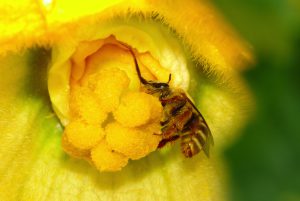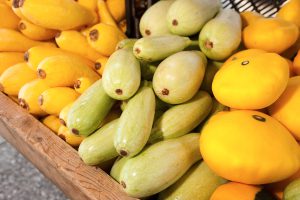Click Here if you listened. We’d love to know what you think. There is even a spot for feedback!
Read along below!
Found in Translation
Bees Riding the Coattails of Crop Plants
By: Jay Evans, USDA Beltsville Bee Lab
Much is made of the challenges faced by honey bees and other pollinators living in agricultural settings and bee lives can, in fact, be brutish and short in some crops at some times. Overall, however, a few bee species have really made croplands work for them (and have shown their benefits to crop production). These species have consequently increased in range and number thanks to humans and our farming habits. This essay focuses on two distinct cases which have gotten recent attention from researchers.
Honey bees have certainly benefited ‘on the whole’ from expansions in human agriculture, since that is often the fire that drives beekeepers to manage colonies and move them in and out of productive settings. The western honey bee has leveraged its known impacts on pollinated plants with an ability to produce harvestable honey and hive-stuffs to achieve a worldwide expansion, reflecting a 20+-fold increase in its native range. This puts honey bees in a very small group of non-human animals that thrive on every continent except Antarctica (hint: all are either parasites of, or benefactors to, our species). This is not to say that farm life is always ideal for honey bees.

Image from the USDA-ARS Image Gallery
There will always be tensions between bees, their keepers and certain farming practices, and recent work documents the importance of smart farming with respect to integrated pest and pollinator management (IPPM). Jacob Pecenka and colleagues (in “Implementing IPM in crop management simultaneously improves the health of managed bees and enhances the diversity of wild pollinator communities”, Scientific Reports (2023) 13:11033, https://doi.org/10.1038/s41598-023-38053-5) demonstrated how treatment regimes for pest beetles in and/or near watermelon crops impact honey bees and other pollinators. In this particular study, bees pollinating watermelons in areas with integrated crop pest management (i.e., applied according to economic thresholds and monitoring, as a beekeeper might do for Varroa treatments) fared substantially better than did bees growing in environments with preordained pesticide use. Importantly, the authors argue that IPM techniques remain viable for protecting crops from their pests, while creating an environment that is safer for pollinators. Remarkably, honey bee colonies showed twice the levels of standing capped brood and nearly double the overall weight gain in areas where IPM methods were deployed.
Bumblebees in managed colonies showed even more striking differences in colony weights, actually retreating in size after six weeks in more hazardous crop environments. Native bees, which fend for themselves, were half as prevalent in these environments. If you want to read up on the roles played by hundreds of native bee species in securing our food supply, check out a recent review by Sabrina Rondreau and colleagues (“Identifying wild bee visitors of major crops in North America with notes on potential threats from agricultural practices (2022), Frontiers in Sustainable Food Systems, 6:943237. Doi:10.3389/fsufs.2022.943237). These authors also highlight watermelons and other members of the squash family, bringing us to an even more remarkable case of a lucky bee whose prospects were greatly improved by human farming decisions.

Image from the USDA-ARS Image Gallery
The squash bee, Eucera (Peponapis) pruinosa, is a ground-nesting bee native to North America, where it and its ancestors pollinated abundant members of the squash family (cucurbits) from what is now the southwestern United States and Mexico for millennia. While less visible and harder to harness than honey bees (in part because of the challenges stated previously), native bees like the squash bee are important for crop production and wildflower pollination. As per its name, the squash bee is a huge reason why you get tremendous squash production each Summer (some will hold that against them after years of overbearing zucchini plants, but remember they also pollinate watermelons, pumpkins and hard squashes!). These bees got their biggest break when indigenous peoples of North America started cultivating squash with passion a thousand or so years ago (after several thousand years of localized cultivation). The love for squash was passed eastward from the desert southwest, eventually reaching the Atlantic Ocean and southern Canada. Nathanial Pope and others tied to the Penn State pollinator laboratory of Margarita Lopez-Uribe (https://lopezuribelab.com/) have been using genes to trace the paths of the squash bee.
In a recent paper (Pope N, Singh A, Childers A, Kapheim K, Evans J, López-Uribe MM. (2023) “Expansion of agriculture drives adaptive evolution in a specialized squash pollinator”, Proceedings of the National Academy of Sciences 20(15): e2208116120) it is shown that one ancestral branch of squash bees was the main hitchhiker during the eastward expansion of squash cultivation. This set of bees might have been especially adept at working with a seasonally abundant, but sporadic, food source, or perhaps could better tolerate the wetter world found outside of the southwestern deserts. The net result is a lucky, and effective, bee that now lives thousands of miles from its ancestral home and in some strongly different environments (some ancestral squash bees have never seen snow, while this branch now digs into the ground to tough out Nova Scotia Winters). The bees did not get moved by humans like honey bees, but instead inched eastward acre-by-acre and year-by-year as squash seeds were planted in strange lands. They are quiet but effective pollinators of squashes to this day, rivalling honey bees especially when stable soils are present and farms are smaller. Like honey bees, they suffer some of the effects of agricultural management (in the Pecenka paper, squash bees were featured in the native bee set that fared much better in smartly managed crops). Nevertheless, there are more squash bees on the planet than ever before, thanks to agriculture. This is a trait they share with our beloved honey bees.







